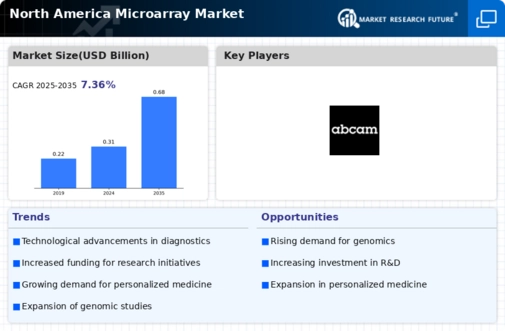North America Microarray Size
North America Microarray Market Growth Projections and Opportunities
The North America Microarray Market is influenced by a multitude of factors that collectively shape its growth and trajectory. One of the primary drivers is the increasing prevalence of genetic disorders and the growing demand for personalized medicine. As genomic research becomes integral to understanding and treating various diseases, microarray technology plays a pivotal role in analyzing gene expression and genetic variations. The ability of microarrays to simultaneously study thousands of genes makes them crucial tools in genomics and molecular diagnostics, contributing to the expansion of the market.
Research and development activities are paramount in shaping the North America Microarray Market. Ongoing advancements in microarray technology, including the development of high-throughput and cost-effective platforms, drive innovation in the field. Researchers and biotechnology companies continually strive to enhance the sensitivity, accuracy, and versatility of microarrays for various applications, such as cancer research, pharmacogenomics, and infectious disease studies. These innovations contribute to the availability of a diverse range of microarray products, meeting the evolving needs of researchers and clinicians.
Government regulations and healthcare policies significantly impact the North America Microarray Market. Regulatory approvals are essential for the introduction of new microarray platforms and diagnostic applications. Compliance with regulatory standards ensures the reliability and safety of microarray-based tests, instilling confidence among healthcare professionals and researchers. Government policies related to genomic research funding, data privacy, and the integration of genomic technologies into healthcare systems influence market dynamics, affecting the adoption and utilization of microarrays.
The role of healthcare infrastructure and collaboration with research institutions is pivotal in the North America Microarray Market. Well-established healthcare systems and partnerships with academic and research institutions support the integration of microarrays into routine clinical and research practices. Improved infrastructure ensures that the benefits of microarray technology can be effectively translated into clinical applications, contributing to the overall growth of the market.
Market competition is a significant factor driving innovation in the North America Microarray Market. The presence of various biotechnology companies fosters competition, leading to the development of diverse microarray technologies and applications. Companies strive to offer microarrays with improved sensitivity, specificity, and automation features, addressing the evolving needs of research laboratories and healthcare facilities. The competitive landscape encourages continuous improvement in microarray functionalities, benefiting the field of genomics and molecular diagnostics.
Public awareness and the increasing importance of precision medicine contribute to the dynamics of the North America Microarray Market. With a growing emphasis on tailoring medical treatments to individual genetic profiles, both healthcare professionals and the general public are becoming more aware of the potential of microarrays in personalized medicine. Educational initiatives by research institutions, healthcare providers, and industry stakeholders further drive awareness, highlighting the role of microarrays in advancing our understanding of genetic factors in health and disease.
Global economic conditions and research funding patterns influence the North America Microarray Market. Economic factors impact funding for genomics research, market access, and the affordability of microarray technologies. As research budgets vary across institutions and industries, economic considerations play a role in shaping the adoption and utilization of microarrays in different research and clinical settings.
The ongoing COVID-19 pandemic has presented challenges and opportunities for the North America Microarray Market. While the pandemic has diverted resources toward infectious disease research and testing, it has also underscored the importance of molecular diagnostics and genomics in understanding and managing health crises. Microarray technologies that enable comprehensive genomic analysis may find increased relevance in infectious disease studies and surveillance efforts.







Leave a Comment